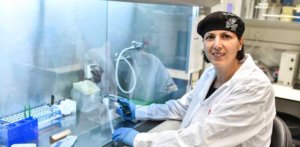
Meet 3 Trailblazing Women – Shulamit Levenberg
Prof. Shulamit Levenberg grows bodily tissues in her lab

As tissues in the body fail or need replacing, a growing number of scientists are creating tissues in their labs that can help with ailments and even save lives when they are added to the body. For more than two decades, Prof. Shulamit Levenberg has been a trailblazer in this area.
Levenberg is dean of the Faculty of Biomedical Engineering at the Technion – Israel Institute of Technology. She is also the head of Technion’s recently founded 3-D Bio-Printing Center for Cell and Biomaterials Printing.
While most people use 3-D printing for fun and entertainment, it is serious business in the biology world – and Levenberg is one of the world’s leading scientists in this vastly growing field.
With tissue engineering, scientists and researchers grow 3-D pieces of tissue in a lab. They do this by taking cells and growing them on 3-D scaffolds. The idea is for the cells to attach to the scaffold, then grow, differentiate and assemble into the tissue. Then, these pieces of tissue can be used for implementation into the body in order to repair or restore damaged tissues in the body.
The process is complex, and the possibilities are far-reaching. In Levenberg’s lab alone, projects have involved bone tissue repair, spinal cord injury regeneration, facial reconstruction – and even developing a form of cell-grown meat that would please the taste buds of meat lovers without sacrificing the lives of animals.
For her BSF-funded project, Levenberg is partnering with Prof. Christopher Chen, who specializes in biomedical engineering at Boston University’s College of Engineering. Their project focuses on vascular remodeling, an intricate process that plays a major role in the clinical manifestations of cardiovascular diseases.
Levenberg credits the BSF grant with enhancing her collaboration with Chen – even before the grant was approved.
“During the preparation and writing of the BSF grant application, we had many discussions, phone calls and Skypes. It was a great opportunity for scientific brainstorming,” Levenberg said. “Chris also interacted directly with my students to discuss the details of the experiments – so this by itself was a great opportunity for the students. The grant allows us to work together on the topics that interest both of us.”
Levenberg’s interest in science blossomed when she was a student at Hebrew University in the 1990s. She studied biology, but then moved to biomedical engineering, a multidisciplinary field that would allow her to study engineering and medicine in addition to biology.
Then she heard about the regulation of angiogenesis in the body – the process in which each tissue controls its own blood supply by sprouting of vessels and defining the complexity of the vascular tree. As she discovered the relatively new field of organ engineering, she wanted to understand more about how human tissue is organized. She focused on tissue engineering, with an emphasis on blood vessels.
She did her PhD at the Weizmann institute on cell adhesion, and her post doctorate research on tissue engineering with Prof. Robert Langer at MIT. Her research showed that it is possible to create complex tissues including blood vessels in a laboratory and that these engineered tissue-constructs can integrate with the host when implanted. She is also developing micro bioreactors and nanoliter droplet devices for stem cell growth and manipulations.
Among several coveted honors, Levenberg received the Krill Prize for excellence in scientific research and the Rappaport Prize for Biomedical Sciences for her work on tissue vascularization. She has also been hailed in Scientific American as a research leader in tissue engineering.
Levenberg believes Israel is fertile ground for this field.
“In general, Israeli students are very open minded. They have lots of courage and very often use out of the box thinking,” Levenberg said. “Students at Technion’s Biomedical Engineering Department are really at the top of their education as both engineers and scientists. This provides them with the best opportunity for becoming innovators in medicine and gives them an excellent toolbox for biomedical research.”
For Levenberg, one of the advantages of the BSF grant is the opportunities it will provide for her students.
“My students and I will visit Chris’s lab and they will have the opportunity to work closely with Chris students,” Levenberg said. “I am very excited about this collaboration.”
